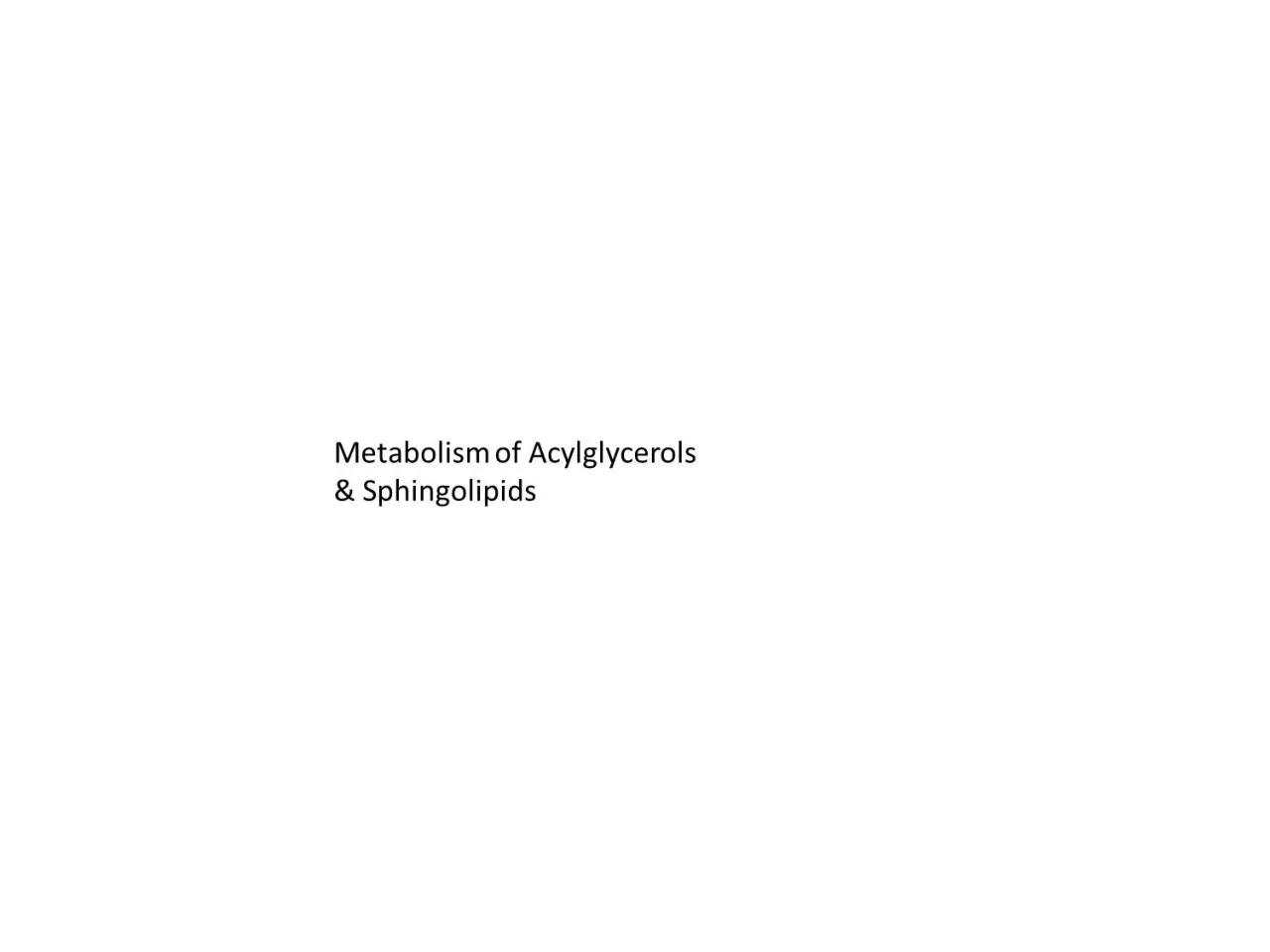

constitute the majority of lipids in the body Triacylglycerols are the major lipids in fat deposits and in food and their roles in lipid transport and storage and in various diseases such as obesity diabetes ID: 929717
Download Presentation The PPT/PDF document "BIOMEDICAL IMPORTANCE Acylglycerols" is the property of its rightful owner. Permission is granted to download and print the materials on this web site for personal, non-commercial use only, and to display it on your personal computer provided you do not modify the materials and that you retain all copyright notices contained in the materials. By downloading content from our website, you accept the terms of this agreement.
Slide1
Slide2BIOMEDICAL IMPORTANCE
Acylglycerols
constitute the majority of lipids in the
body.
Triacylglycerols
are the major lipids in fat deposits
and in food, and their roles in lipid transport and
storage and in various diseases such as obesity, diabetes,
and
hyperlipoproteinemia
.
The
amphipathic
nature of phospholipids
and
sphingolipids
makes them ideally suitable as
the main lipid component of cell membranes. Phospholipids
also take part in the metabolism of many
other lipids. Some phospholipids have specialized functions;
eg
, dipalmitoyl lecithin is a major component of
lung surfactant, which is lacking in respiratory distress
syndrome of the newborn.
Inositol
phospholipids in the
cell membrane act as precursors of
hormone second
messengers, and platelet-activating factor is an
alkylphospholipid
.
Glycosphingolipids
, containing
sphingosine
and sugar residues as well as fatty acid and found in
the outer leaflet of the plasma membrane with their
oligosaccharide chains facing outward, form part of the
glycocalyx
of the cell surface and are important (1) in
cell adhesion and cell recognition; (2) as receptors for
bacterial toxins (
eg
, the toxin that causes cholera); and
(3) as ABO blood group substances. A dozen or so
glycolipid
storage diseases have been described (
eg
,
Gaucher’s
disease,
Tay
-Sachs disease),
Slide3TRIACYLGLYCEROLS &
PHOSPHOGLYCEROLS ARE FORMED BY
ACYLATION OF TRIOSE PHOSPHATES
substances such as
triacylglycerols
,
phosphatidylcholine
,
phosphatidylethanolamine, phosphatidylinositol,
and
cardiolipin
, a constituent of mitochondrial membranes,
are formed from glycerol-3-phosphate. Significant
branch points in the pathway occur at the
phosphatidate
and
diacylglycerol
steps. From
dihydroxyacetone
phosphate are derived phosphoglycerols containing an
ether link , the best-known of which
are
plasmalogens
and platelet-activating factor (PAF).
Glycerol 3-phosphate and
dihydroxyacetone
phosphate
are intermediates in
glycolysis
, making a very important
connection between carbohydrate and lipid metabolism
Slide4Remodeling of Phosphoglycerols
Although phospholipids are actively degraded, each
portion of the molecule turns over at a different rate—
eg
, the turnover time of the phosphate group is different
from that of the 1-acyl group. This is due to the
presence of enzymes that allow partial degradation followed
by
resynthesis
Phospholipase A2
catalyzes the hydrolysis of
glycerophospholipids
to form
a free fatty acid and
lysophospholipid
, which in turn
may be
reacylated
by
acyl-CoA
in the presence of an
acyltransferase
.
Slide5lysolecithin)
is attacked by
lysophospholipase
, forming
the corresponding glyceryl
phosphoryl
base, which in
turn may be split by a
hydrolase
liberating glycerol
3-phosphate plus base.
Phospholipases
A1, A2, B, C,
and D attack the bonds
in T.G .
Phospholipase
A2 is found in pancreatic fluid and
snake venom as well as in many types of cells;
phospholipase C:
is one of the major toxins secreted by bacteria;
and
phospholipase
D is known to be involved in
mammalian signal transduction.
Slide6CERAMIDE:
Ceramide
is synthesized in the endoplasmic reticulum
from the amino acid serine
Ceramide
is an important signaling molecule (second
messenger) regulating pathways including
apoptosis
(processes leading to cell death), cell senescence, and
differentiation, and opposes some of the actions of
diacylglycerol
.
Sphingomyelins
are phospholipids :
and are formed when
ceramide
reacts with
phosphatidylcholine
to form
sphingomyelin
plus
diacylglycerol
This occurs mainly in the Golgi
apparatus and to a lesser extent in the plasma membrane
.
Slide7Slide8Glycosphingolipids
Are a Combination
of
Ceramide
With One or More
Sugar Residues
The simplest
glycosphingolipids
(
cerebrosides
) are
galactosylceramide
(
GalCer
) and
glucosylceramide
(
GlcCer
).
GalCer
is a major lipid of myelin, whereas
GlcCer
is the major
glycosphingolipid
of
extraneural
tissues and a precursor of most of the more complex
glycosphingolipids
.
Sulfogalactosylceramide
and other
sulfolipids
such as the
sulfo
(
galacto
)-
glycerolipids
.
Gangliosides
are synthesized from
ceramide
by the stepwise addition of activated sugars (
eg
,
UDPGlc
(
uridindiphosphate
glucose) and
UDPGal
) and a
sialic
acid, usually
Nacetylneuraminic
acid
Slide9CLINICAL ASPECTS
Deficiency of Lung Surfactant Causes
Respiratory Distress Syndrome
Lung surfactant is composed mainly of lipid with
some proteins and carbohydrate and prevents the alveoli
from collapsing. Surfactant activity is largely attributed
to
dipalmitoylphosphatidylcholine
, which is
synthesized shortly before parturition in full-term infants.
Deficiency of lung surfactant in the lungs of
many preterm newborns gives rise to
respiratory distress
syndrome. Administration of either natural or artificial
surfactant has been of therapeutic benefit
Slide10Phospholipids &
Sphingolipids
Are Involved in Multiple Sclerosis
and
Lipidoses
Certain diseases are characterized by abnormal quantities
of these lipids in the tissues, often in the nervous
system. They may be classified into two groups: (
1) true
demyelinating
diseases and (2)
sphingolipidoses
.
In
multiple sclerosis, which is a
demyelinating
disease,
there is loss of both phospholipids (particularly
ethanolamine
plasmalogen
) and of
sphingolipids
from
white matter.
Thus, the lipid composition of white
matter resembles that of gray matter. The cerebrospinal
fluid shows raised
phospholipid
levels.
The
sphingolipidoses
(lipid storage diseases) are a
group of inherited diseases that are often manifested in
childhood. These diseases are part of a larger group of
lysosomal
disorders and exhibit several constant features:
Complex lipids containing
ceramide
accumulate
in cells, particularly neurons, causing neurodegenerative diseases